#scandinavian references
Explore tagged Tumblr posts
Text




The diagram for the classic Origami Goat, with a twist to make its horns curve ! It's from this video by by Origami Word, but it seems to be a pretty old/intemporal design that a lot of people have made. I could not find a diagram online so I made one.
(If you make her in yellow/orangy-yellow, then decorate her with red ribbons, you can make your own origami gävlebocken ! )

#She'll be about a third of the size of the original paper#origami diagram#gävlebocken#origami goat#origami#gavlebocken#fun fact that not a lot of people might know : gälvebocken only refers to the goat of the city of Gälve !#however lil goats made of straws are a classic -around christmas- ornament/decoration - especially in northern europe/scandinavian countries#and they're called julbocken !#so yeah technically your little goat can be decorated as a julbocken *like* the gävlebocken is ^^#(but i put that into the gävlebocken tag because i felt like people might want to know they can make a flammable origami of the gävlebocken)
17K notes
·
View notes
Text
"The trumpet trombone shall sound", from Händel's Messiah
[source] performed by Créatine Price (voice, insta @/creatineprice), Tilda Watersclear (trombone, insta @/tildawatersclear) and Felix Jarrar (piano, insta @/the_original_fefe) during the lead-up to Drag Messiah in September 2024
the original text is of course "the trumpet shall sound", from 1st Corinthians 15: 52-53, and is scored for trumpet. in this performance they light-heartedly switch it up for trombone.. but interestingly, German Bible translations do actually render that passage as "the trombone shall sound" ! for example, Martin Luther's 1545 translation with which Händel himself would undoubtedly have been familiar reads : "Denn es wird die Posaune schallen"
#handel#the messiah#music#trombone#most bible translations seem to go with trumpet or bugle which is normal. Dutch uses bazuin which is specifically a medieval herald trumpet#besides German I think the Scandinavian langauges also go for trombone for some reason#the Afrikaans PWL translation of 2016 bizzarely renders it as ram's horn or shofar. the original text is of course Greek#and refers to the ancient Mediterranean instrument the salpinx. which is a metal trumpet like instrument and certainly not a ram's horn#the normal Afrikaans translations go with trumpet or basuin like the Dutch
6 notes
·
View notes
Text
Imagine a travel episode where it's the Scandinavian Trio travelling through Italy or Spain but they're all just collectively ganging up on Sweden (who this trip is for) and messing with him, and both Denmark and Norway are basically just Conan O'Brien with Jordan on their trip to Italy I think that would be so funny 💀







#hetalia#soap is talking#hws sweden#hws denmark#hws norway#scandinavian trio#headcanons#headcanon#aph sweden#aph denmark#aph norway#I love Conan this trip just screams “brothers mocking Sweden” to me 😂😂😂#it's like they specifically booked this trip for Swe because he loved visiting so they think they've earned additional rights to tease him#I love Conan the golden god of Finland#<- an old Conan O'Brien reference 👀👀#hetalia sweden#hetalia denmark#hetalia norway#seriously guys look up “Conan and Jordan Italy trip” on youtube y'all will not be disappointed!!#there's a lot more I can edit in but it was 2 AM when I made this so I'm lazy n sleepy now sleep tight xoxo
20 notes
·
View notes
Text

Reference Sheet - Sven Haraldsson
This is a character of mine named Sven Haraldsson, an Icelandic Norse Viking from the 10th century AD. After one of Iceland's volcanic eruptions devastates his village, Sven goes on a raiding expedition to the region of Senegambia in West Africa, hoping to obtain some gold to help rebuild his family's fortune. Warriors from one of the local Serer villages ambush Sven's party and take him captive, but he offers to help them out on some mission in exchange for his freedom (and some of their gold), with their wise and beautiful saltigue (priestess) Mossane tagging along and becoming his love interest. I've still yet to decide on what that mission is, but hopefully it will be packed with action and adventure!
#original character#character design#reference sheet#viking#norse#scandinavian#european#digital art#art
2 notes
·
View notes
Text
kinda delighted to see fairly obscure norwegian medieval folklore (pesta) showing up in the witcher 3.
kinda weirded out there's a character whose name is just the norwegian word for limestone (kalkstein).
#i'm assuming there's some overlap between scandinavian and eastern european folklore#but pesta is very specifically 14th century norway. love me some pesta#also i laughed at a reference to a Stygga castle even though that one was definitely unintentional#'stygga' is how you'd address someone (female) as 'ugly' to their face#slett's play
3 notes
·
View notes
Text
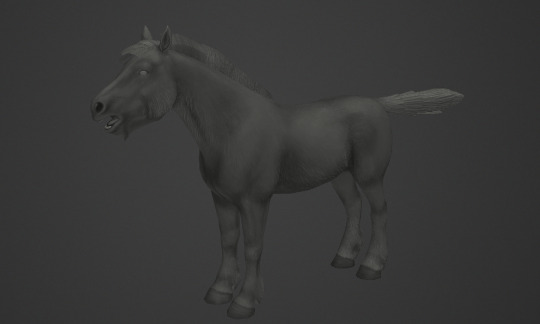
first thing I'm doing with my new power is adding Mongolian/Altai inspired horses to Solstheim
#at least one will have the leopard complex#since it doesn't appear in any of the scandinavian breeds I reference for nordic horses#but it is absolutely a thing in altai horses#for more southern/mainland morrowind I'd lean more heavily on the mongolian side#but I think a mainly siberian breed actually works well for solstheim#and I want spots
6 notes
·
View notes
Text
love elder scrolls horse lore
#thinking about oblivion horse speeds. and skyrim wild horses creation club. naming horses.#the wild horses randomized names r just like actual scandinavian names. i randomized it and got loki and went OH FUCK NO and rerandomized it#there shall be no lore-unfriendly norse mythology references in my skyrim
2 notes
·
View notes
Text
i am misuse case and I have never felt so seen in my entire tumblr life.
ur government assigned gender for the day is the first thing u get when u click this link to a randomised wikipedia article. NO REROLLS . i am the trollsteineggje mountain in norway
#another Norwegian reference too#im sensing a pattern wiki#and I’m not complaining#this Scandinavian is a scandalous-knave-ian#be gay#literally do crime
125K notes
·
View notes
Text
has anyone figured out whom "the econoclards" are meant to be a reference to
#all i can think of is lenin's critique of economism but i feel like it's something else#like. what about spreadsheets obsession#what about the beans#also chavism maybe? but the questions above remain#i don't think it's a reference to scandinavian social democracies as they already have them at home (in elysium)
0 notes
Text
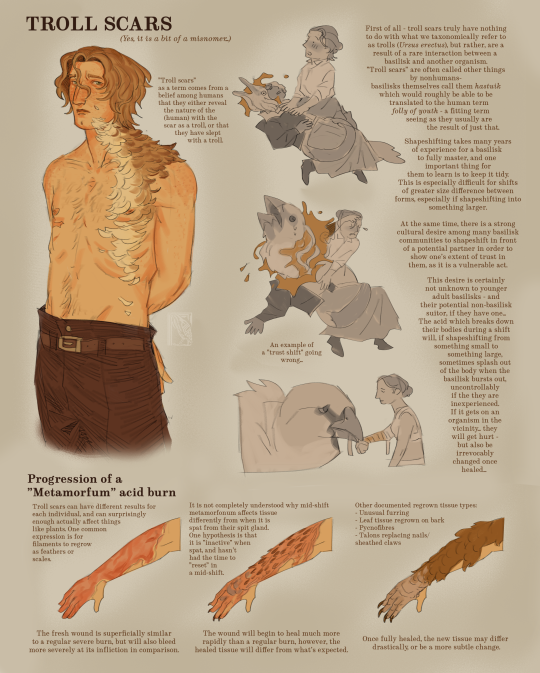
Well i have decided to make a little silly phenomenon in pareidolia so. yes folke is used as an example for a reason no i wont elaborate... but i will elaborate about the phenomenon below...
most humans associate the scars with trolls (keep in mind this is about basilisks in the nordics so) because of the idea that trolls shapeshift (in Pareidolia Reality they don't and the "real" trolls are more baueresque than the more traditional view. but its all human terminology anyway lol). any humans with troll scars tend to try to hide them bcs of it, but it can be hard depending on how extensive they are - if you just got a scar where you have extra furring, you may just be able to shave it. if you got the feather variant, it might suck a bit more lol...
troll scars are premanent, the tissue it affects will be forever changed.
filament tends to be somewhat adapted to fit where the original tissue was. claws won't grow from random patches of skin etc.
pigment is usually inherited from the scarred individual, but on rare occasions it may spontaneously "pick up" on local bird species pigmentation like basilisks do in development (as baby)
metamorfum acid burns heal very fast - a large area can heal in about as little as a month. but that's just for the "superficial" healing, and it will appear like a normal burn scar at first until it'll slowly start to grow the new filaments or the tissue will appear to "change".
basilisk acid burns rarely ever go deeper than the skin because it stops being active fast after exiting the basilisk body.
many basilisk cultures are hesitant about interspecies relationships (with other sophonts i mean) using hastuik as a justification. interestingly enough, metamorfum accidents don't seem to affect harpies as badly, probably because the two species are related, so there's usually less of a hesitation in regards to those relationships. it may vary however from community to community
hastuik is a basilisk term (well among scandinavian basilisks) which often refers to these scars but also in other contexts and is also a combination of two words - "hastu", which is also a family suffix (used for chicks before they pick their name), whose meanings include young/youth, chick and naiveté, while "ik" can be translated to foolishness/stubbornness (specfically with the connotation that it is unreasonable). calling another basilisk hastuik is basically calling them naive/childish in a derogatory sense since the term is kind of obsolete for them anyway (the acid burns heal normally for them)
#worldbuilding#fantasy#speculative evolution#spec evo#spec bio#speculative zoology#speculative biology#speculative fantasy#cw: injury#cw: burn#for the little diagram at the bottommmm#pareidolia tag#oc: folke#bestiary#basilisk#lore#artists on tumblr#art
1K notes
·
View notes
Text

April 2025 Set - Scandinavian Home
Making your Sims’ homes look effortlessly cozy just got easier. The main pieces in the set come decorated, so you can skip the styling and jump straight into the vibe.🌿💛
PATREON



Reference

#sims4#sims4cc#ts4#ts4cc#thesims4#thesims4cc#cowbuild#cc#sims4ccfinds#ts4ccfinds#showusyourbuilds#심즈4#sims#심즈4cc#シムズ4#シムズ4cc#模拟人生4#模拟人生4cc
659 notes
·
View notes
Text
ever wanted to learn Old Norse but put off by how most resources expect you to have familiarity with Latin grammar?


The viking language series is designed for interested language learners without expecting them to have prior knowledge of other languages. These books use a word-frequency method that speeds up learning and is for students of all levels.
Beginners will be reading Old Norse texts from the first lesson, while advance students have ample vocabulary, grammar, and pronunciation for improved fluency. It includes sections of viking history, literature, and myth with extensive maps throughout.
The second volume builds upon the first, and includes a reference grammar and a large vocabulary along with chapters on Eddic and skaldic poetry. Readings that immerse learners in the Old Norse world include complete sagas, runic inscriptions, myths, creation stories, and legends, Eddic poems tell about Scandinavian gods, monster-slayers, dwarves, giants, warrior kings, shieldmaidens, and Valkyries.
Order volume 1 and volume 2 online here, or ask your local bookstore about stocking our editions!
284 notes
·
View notes
Text
Witchcraft In Media
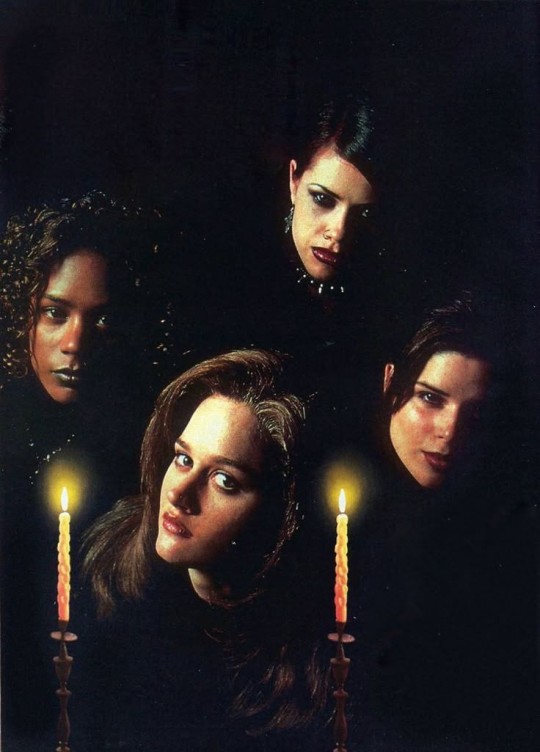
While most depictions of witchcraft in movies and TV shows are sensationalized for entertainment, some portrayals incorporate authentic elements from historical, folkloric, and modern witchcraft practices. Here are some of the most accurate depictions:
Movies
• The VVitch (2015) – One of the most historically accurate depictions of 17th-century Puritan fears of witchcraft, featuring real folklore, rituals, and paranoia about witches.
• Häxan (1922) – A silent documentary-horror film about medieval witch trials, based on historical accounts.
• The Craft (1996) – While dramatized, it incorporates real Wiccan elements, spellwork, and the ethics of magic.
• Practical Magic (1998) – Features real herbalism, divination, and folk magic traditions blended with fantasy elements.
• The Love Witch (2016) – Stylized but captures real elements of glamour magic, spell-casting, and the psychological aspects of witchcraft.
• A Dark Song (2016) – A rare and realistic portrayal of ceremonial magic, based on the Abramelin ritual, which is a real occult practice.

TV Shows
• Salem (2014–2017) – Though dramatized, it draws on real 17th-century witchcraft beliefs and Puritan fears.
• Luna Nera (2020, Netflix) – Based on real Italian witch hunts and folklore, focusing on midwives and cunning women.
• Chilling Adventures of Sabrina (2018–2020) – Uses real occult symbols, ceremonial magic, and references to historical witchcraft practices, though blended with fantasy.
• Penny Dreadful (2014–2016) – Features historical witchcraft lore, including Verbis Diablo, necromancy, and folk magic elements.
• American Horror Story: Coven (2013) – While exaggerated, it incorporates elements of real New Orleans voodoo, hoodoo, and folk magic.
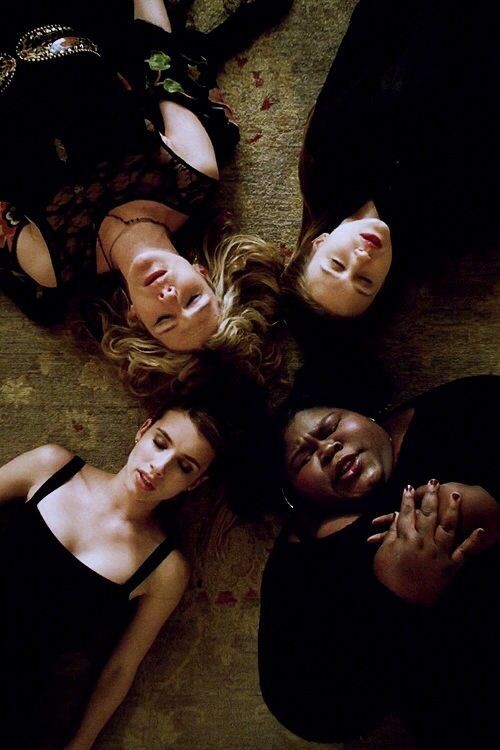
Cartoons & Animated Shows
• The Owl House (2020–2023) – Features sigil magic, covens, and different branches of magic inspired by real mystical traditions.
• Over the Garden Wall (2014) – Uses folklore-inspired magic and eerie Americana witchcraft themes.
• Kiki’s Delivery Service (1989) – A gentle, accurate take on hedge-witchery, showing a young witch using magic for simple, everyday purposes.
• Hilda (2018–present) – Explores Scandinavian and European folklore, including real folk-witch elements.

Honorable Mentions (Folklore-Inspired, but Not Entirely Accurate)
• The Wicker Man (1973) – Paganism-based but leans more into horror than actual witchcraft.
• The Blair Witch Project (1999) – Uses real witch lore but is entirely fictional.
• Suspiria (1977 & 2018) – Features elements of real occult and esoteric traditions related to dance and ritual magic.
• Sleepy Hollow (1999) – Includes genuine European witchcraft folklore, mixed with gothic horror.

#witchcraft#media#tv shows#movies#cartoons#anime#witch#magick#lefthandpath#witchblr#witch community#eclectic witch#eclectic#pagan#witchcore#american horror story#practical magic#owl house#kiki's delivery service#the craft#blair witch#representation#Accurate#realistic#sabrina the teenage witch#the vvitch#stories#Accuracy#dark#satanic witch
75 notes
·
View notes
Text
Book Review: Freya: Meeting the Norse Goddess of Magic by Morgan Daimler

I just finished a reread of this book and realized I've never talked about it on this blog, even though it ties into a lot of my content.
I've talked about my relationship with Freyja here before. She is the deity I have worked with most consistently in my personal practice, and she's been a strong presence in my life since I was a child. Even before I was interested in witchcraft or paganism, I was drawn to stories and images of Freyja.
Unfortunately, quality books about Freyja are hard to find in English. A lot of the wonderful work being done by Scandinavian scholars and heathens is only available in their native languages. A lot of English-language resources are either very academic and prohibitively expensive, or they are books about goddess worship more generally that only mention Freyja on a few pages. Freyja, Lady, Vanadis: An Introduction to the Goddess by Patricia M. Lafayllve is a pretty good beginner's resource, but it's only available in paperback, which can be a barrier for some readers.
All of this is to say, I was very excited when Morgan Daimler put out this book. I've talked about how much I love Daimler's work before on this blog -- I think they do really great research AND do a really good job of making all that information accessible for a beginner. I have several of Daimler's books on Norse and Irish deities, and all of them are resources I reference often in my practice.
This book follows a similar formula to Daimler's other books on deities, like Odin or the Morrigan. Daimler presents Freyja's mythology, folklore, associations, and relationships. There is also an entire chapter dedicated to Freyja's connection to seiðr, which explains what seiðr is and why it is important in a very straightforward way. There is also an entire chapter dedicated to connecting with Freyja as a modern worshiper.
I like that Daimler includes a section at the end of each chapter about their own experiences with Freyja. I also like that they talk about the importance of actually experiencing the gods and trusting our experiences. It's easy to fall into the trap of thinking that anything that doesn't match up with primary sources is wrong, and I like that Daimler takes time to shoot down that idea.
I also really like that Daimler does not tell you how to interpret the lore. Daimler presents a story, explains the different ways it could be interpreted, and leaves readers to make their own conclusions. This is a style of teaching I try to use in my own work, and I love seeing it done well here.
If you know next to nothing about Freyja, I think this book is an excellent place to start. Everything you need to make that initial connection is here.
Even as someone who has worked with Freyja for years and done lots of my own research, I found a few things I didn't know here. This book also gave me a new perspective on certain aspects of Freyja's lore. This is why it's always great to compare notes with other people.
If you're interested in connecting with Freyja or just learning more about her, I highly, highly recommend this book!
#insert [finally some good fucking food] meme here#book review#book rec#book recommendations#books#freyja#freyja deity#freya#freya deity#inclusive heathenry#norse heathen#norse paganism#heathenry#norse mythology#norse#paganism#deity work#morgan daimler#witch#witchblr#pagan#history#my writing#mine
155 notes
·
View notes
Text
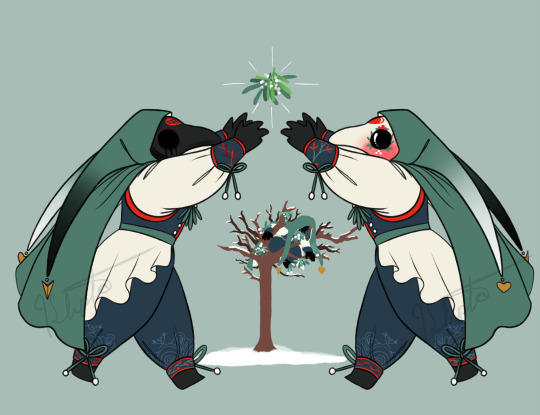
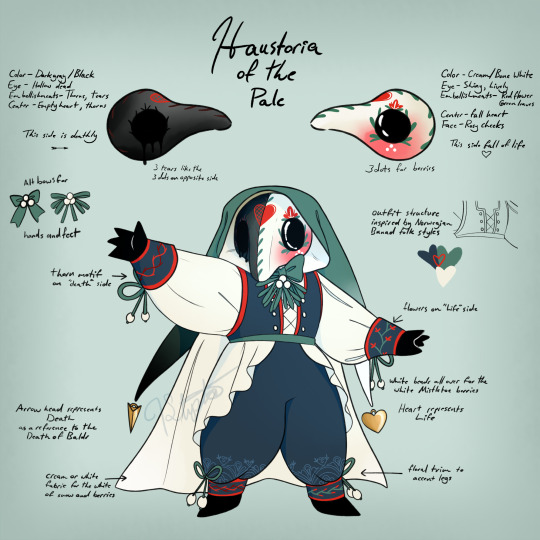
You’re walking down a long quiet road. It’s winter, snow covers the ground, the sky fades gray. All around you are trees that have long since dropped their leaves, cold and dead, waiting for spring. You stop beneath one, eye caught by a striking sight. Amid the bare branches you see a round bundle of stunning green leaves. Hanging down above you are dozens of beautiful little pearly white berries. The fruit tempts you, but you don’t dare touch. Instead you simply admire them. Life among the dead of winter. Mistletoe.
@slocotion Hi, here is my design for slocotion's patreon dyo doll contest. Her name is Haustoria of the Pale. I was very excited to put this together once it struck me. I thought of all my favorite fruits I could have used but then inspiration hit me as I was considering less common fruits and fungi. Mistletoe is used medicinally by some but the entire plant, including its cute white berries, is toxic. Since this is a longer post, I’ll include more notes on my design under a cut but to point out the most important thing, I’ve combined the nature of the toxic berries with some historical+mythological inspiration that I think echoes it nicely.
In Norse mythology, a well known story is that of the death of Baldr. Baldr was the most loved god of the Aesir, so when a vision of his death reached his parents Odin and Frigga, they did all they could to protect him. Frigga sent her servants all over the world to make every creature and thing vow to never harm a hair on Baldr’s head. All but mistletoe promised, too insignificant or too young to make the vow. After it was done, Bladr seemed invincible. Since nothing was willing to hurt him, the gods would sometimes gather around and throw things at him, watching everything bounce off without injuring him. Loki, jealous of the love and affection that was always paid to Baldr, came up with a plan to get rid of him. He had an arrow made of mistletoe and brought it to Baldr’s blind brother Hodr. He gave it to him to throw at Baldr as all the gods pelted him with objects and weapons. Hodr threw the arrow and, since mistletoe had never promised not to harm him, it pierced his chest, killing him instantly... And so Baldr was delivered to the depths of the land of the dead, looked over by Hel.
specific design notes under the cut thank you for looking!
Mistletoe is a very interesting plant to me. It’s not a tree or vine or bush, but instead its an evergreen parasite. The sticky seeds attach themselves to the branches and grow into it with a haustorium, which is a structure that lets them sap nutrients from the host plant. Haustoria’s name is a reference to this structure. “of the Pale” is a reference to not only the color of the berries but the pale gray and white landscape of winter.
Mistletoe berries are heavily toxic but also exist in winter, when other plants may be barren and “dead.” Because of that and their parasitic nature I see them as a sweet little balance of life and death. In addition to that, I use the split colors of the face/mask of Haustoria to reference the goddess of the land of the dead, Hel, who is described as having a body that is half black as death, split down the middle.
The structure of the outfit is inspired by Scandinavian and specifically Norwegian folk dresses, since I’m borrowing old Norse history for more inspiration, it seemed fitting. I also felt the style would be good to accompany the botanical and berry designs attractively.
The twin peaked hood is to further split the design down the middle, with little charms to show life and death.
I included white beads all over the outfit to represent the mistletoe berries themselves so they could stand out.
The dark side of her face is adorned with thorns and has three mournful black tears leaking down from her eye, as well as a hollow half of the center heart.
The light side is blushed and lively with shiny eyes, leaves shaped like the mistletoe leaves, red petals like the mistletoe blooms, three white dots to be the mistletoe fruit, and the center heart is full.
Her cape is white on the inside to represent the white of the berries and also the white of snow.
To cap it off, I do believe mistletoe is fitting for a plague doctor as they are still used medicinally to this day. :)
Thank you for reading everything and looking at my design! I’m very proud of her and I hope she doesn’t stretch the theme. And definitely more than anything else I hope you enjoy looking at her!
#I hope you like her#I suddenly was struck with a vision of this design so I had to drop everything to work on her for a few days#sorry for the long post though I had a lot of thoughts#<3333#good luck to all the entrants I have been having fun looking at the other cute designs#I take immense interest in both botany and Norse mythology#kleptodoesart
446 notes
·
View notes
Text
A brand new species of ceratops, or horned dinosaur, was recently discovered in northern Montana. This discovery was published in the journal PeerJ last week. The dinosaur is called Lokiceratops rangiformis, after the Norse god Loki, and is believed to have lived roughly eighty million years ago. Researchers named it so for two reasons: 1. Like all ceratops, it has horns on his head — and in this case, they remind researchers of the blades on Loki's helmet. 2. The recovered skull currently resides in the Museum of Evolution in Denmark, one of the Scandinavian countries responsible for the story of Loki. The second part of the name, rangiformis, refers to the horns not being symmetrical, like caribou.
Continue Reading.
214 notes
·
View notes